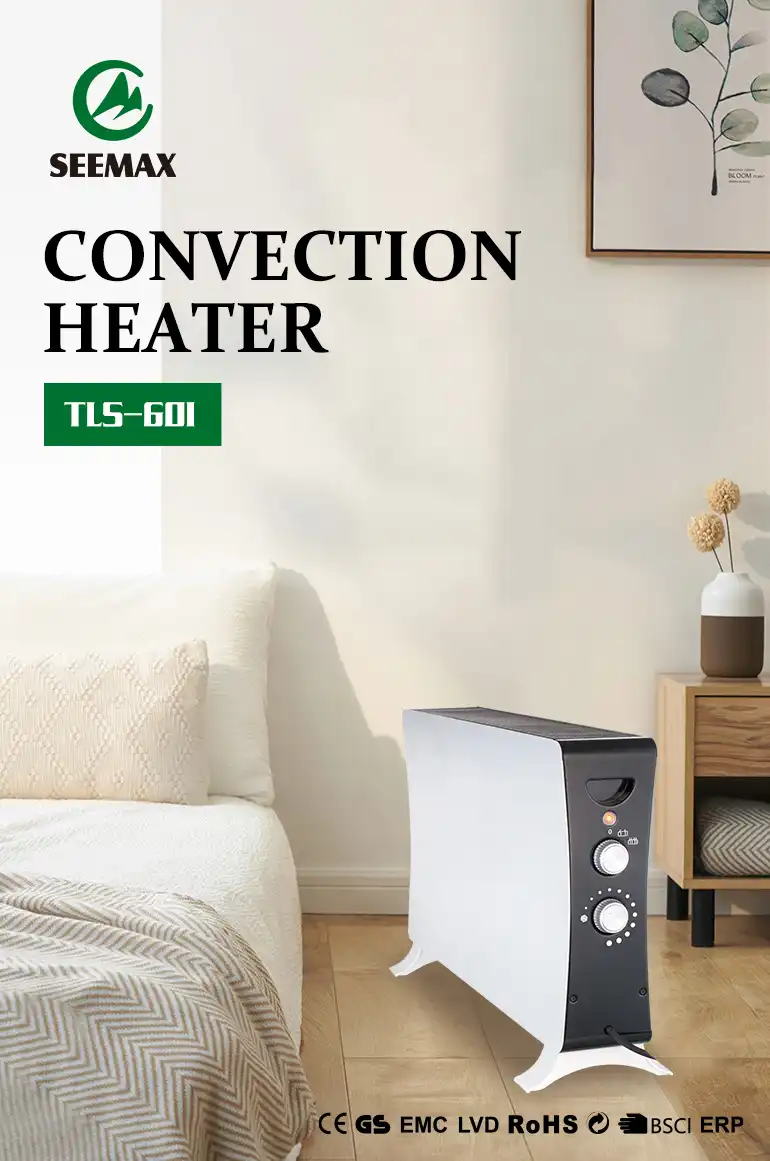No data
07
2025
-
04
Convection vs. Radiant Electric Heaters: A Comprehensive Energy Efficiency Analysis
sales28@seemax.com.cn

When choosing between convection and radiant electric heaters, understanding their energy efficiency, operational principles, and ideal use cases is critical. Both technologies convert electricity into heat, but their mechanisms, performance, and suitability vary significantly. This in-depth comparison explores five key factors to help you determine which heater type aligns with your needs while optimizing energy consumption.
1. Thermodynamic Principles: How Convection and Radiant Heaters Transfer Energy
Convection Heaters: Circulating Warm Air for Uniform Heating
Convection heaters operate by warming the surrounding air, which then circulates naturally or via a fan. The heating element (often metal or ceramic) heats the air, reducing its density and causing it to rise. Cooler air replaces it, creating a continuous cycle that gradually raises the room temperature.
Key Characteristics:
Relies on air movement – Effective in enclosed spaces with minimal drafts.
Slower heat-up time – Takes longer to warm a room but maintains steady warmth.
Best for whole-room heating – Ideal for bedrooms, offices, and living areas.
Radiant Heaters: Direct Infrared Heating for Instant Warmth
Radiant heaters emit infrared waves that travel unimpeded through air, directly warming people and objects in their path—similar to sunlight. Unlike convection, they do not rely on air circulation, making them more efficient in drafty or open spaces.
Key Characteristics:
Instant heat delivery – No warm-up delay; ideal for quick, localized warmth.
Minimal air disturbance – Does not circulate dust, benefiting allergy sufferers.
Best for spot heating – Perfect for garages, patios, or personal workspaces.
Long-Tail Keyword Insight:
"Do radiant heaters save more energy than convection?" – Only in targeted applications; radiant is more efficient for direct heating, while convection excels in sustained ambient warmth.
2. Energy Conversion Efficiency: Do They Waste Electricity?
Both convection and radiant heaters use resistive heating elements, converting nearly 100% of electrical energy into heat. However, real-world efficiency depends on:
Heating Element Design & Materials
Ceramic vs. Metal Coils: Ceramic elements (common in convection heaters) retain heat longer, improving efficiency.
Infrared Emissivity: High-quality radiant heaters use quartz or carbon filaments, optimizing infrared output.
Operational Heat Loss
Convection heaters lose some heat through air leaks in poorly insulated rooms.
Radiant heaters lose efficiency if objects block their infrared waves.
Factual Data:
A 1,500W convection heater running for 1 hour consumes 1.5 kWh, same as a radiant heater. However, radiant may feel warmer faster, allowing shorter usage times.
3. Heat Distribution & Response Time: Which Heater Warms Faster?
Convection Heaters: Gradual but Consistent Warming
Pros: Even heat distribution over time, better for long-term use.
Cons: Slower to feel warm; heat rises, leading to stratification (cold floors, warm ceilings).
Radiant Heaters: Immediate but Localized Heat
Pros: Instant warmth where needed—no waiting for air circulation.
Cons: Uneven heating; areas outside the infrared beam stay cold.
Practical Example:
In a drafty workshop, a radiant heater warms you immediately, while a convection heater struggles due to air leaks.
In a well-insulated bedroom, convection maintains steady warmth overnight.
4. Air Quality, Humidity, and Health Considerations
Convection Heaters: Potential Air Dryness & Dust Circulation
Dry Air Effect: Warm air holds more moisture, potentially lowering humidity.
Dust Movement: Fan-assisted models can spread allergens.
Radiant Heaters: Minimal Air Interference
No Air Circulation: Better for asthma/allergy sufferers.
No Humidity Reduction: Does not dry out the air like convection.
Expert Tip:
Pair a convection heater with a humidifier to counteract dryness.
Radiant heaters are superior in dust-sensitive environments (e.g., medical offices).
5. Best Applications: Which Heater Should You Choose?
| Scenario | Best Heater Type | Why? |
|---|---|---|
| Whole-room heating (living room, bedroom) | Convection | Even, sustained warmth. |
| Spot heating (workshop, patio) | Radiant | Instant, direct warmth. |
| High-ceiling spaces (warehouses, lofts) | Radiant | Avoids heat stratification. |
| Allergy-prone households | Radiant | No dust circulation. |
| Energy-saving with smart controls | Both (with thermostat) | Prevents overuse. |
Final Verdict: Which Heater Is More Energy Efficient?
The answer depends on how you use it:
Radiant heaters win for quick, targeted warmth (e.g., garages, outdoor spaces).
Convection heaters win for long-duration, whole-room heating (e.g., bedrooms).
Pro Tips for Maximum Efficiency:
✔ Use a programmable thermostat to avoid overheating.
✔ Improve insulation to reduce heat loss.
✔ Combine both types—radiant for immediate warmth, convection for sustained comfort.
Ultimately, neither heater is universally "more efficient." Your choice should align with room size, insulation, and heating needs to maximize energy savings.
Final Thought:
"The most efficient heater is the one used correctly for its intended purpose."
By understanding these key differences, you can make an informed, energy-conscious decision between convection and radiant electric heaters.
Related News
undefined
